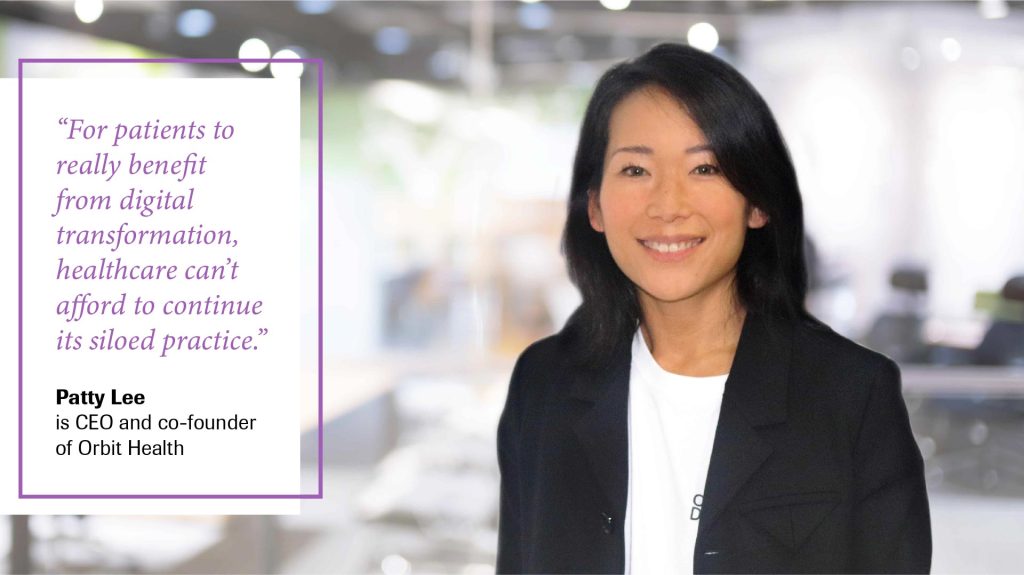Note: This article was originally written and published by Roche Diagram. To see the original article, please click the link here.
COVID-19 has normalised the use of digital solutions in healthcare delivery, turning long-held skepticism into a greater willingness to utilize such technologies.
This growing openness to health tech innovations is a boon to the region’s health systems that are seeking ways to address immediate needs as well as longstanding problems of access and unequal standards of healthcare.
Patty Lee, CEO and co-founder of Orbit Health, a health technology company, believes startups can help to fill the gaps and drive patient-centric care in new ways.
Q. What role do you see digital solutions playing in chronic diseases like Parkinson’s Disease and how has your company pushed for health technology innovation?
When it comes to chronic diseases, one of the main problems for doctors is having to rely on a snapshot of information to treat a disease that the patient lives with 24/7.
This significantly limits personalisation because clinical decisions are based on a one-off approach or a narrow time frame. Secondly, it can be challenging for healthcare professionals to participate early in the patient’s journey as oftentimes they see the patients after an adverse event.
In Parkinson’s, every patient is different – from their symptoms to their response to treatment. In general, patients see their doctors every three to six months for 15-20 minutes. And when the patient goes home, the doctor has no insight into how the patient is responding to the treatment, so it is very hard to tailor and optimise medications.
This is why we have developed a remote monitoring artificial intelligence (AI) solution which turns passively-captured, raw motion data from a smartwatch into objective, continuous symptom insights. It allows doctors to tailor medications, dosage, and schedules to ensure patients stay in the optimal therapeutic range, thereby maximizing symptom control.
Like glucose monitoring in diabetes care, our solution is like dopamine level monitoring for Parkinson’s care. It is designed to address the devastating motor fluctuations that many Parkinson’s patients experience.

Q. What does the high degree of personalization mean for patients who want more ownership in the process of improving their health?
While personalized treatment is not a new phenomenon, what we’re now seeing is that digital health solutions and digital biomarkers are enabling n-of-1 trials and precision medicine. This enables us to perform health interventions at the level of a single individual. This has huge potential to shift the paradigm, particularly for chronic disease management, allowing it to be more proactive, effective, and sustainable.
But beyond treatment personalization, establishing a sense of control and confidence is really important for the patient to carry on with their daily lives and attain quality of life. I’ve seen patients afraid of accepting family birthday invitations because they don’t know how they will respond to medication on that day. This fear of uncertainty is devastating.
The attitude of proactive management, or in other words, knowing that there’s something one can do to mitigate risks or to improve their health and quality of life, is empowering.
Q. The rising burden of chronic diseases is a concern for health systems. What solutions should governments consider as they lay the foundations for a digitally powered health ecosystem?
I believe digital health can really help in chronic disease management. By harnessing sensor and AI technologies, digital tools can offer continuous and objective insights that are otherwise unavailable to enable early intervention and precision medicine. However, the healthcare environment today does not necessarily support the routine clinical adoption of such tools.
And a lot of it has to do with aligning incentives. Instead of incentivizing healthcare providers to treat a sick patient, there should be greater focus on ensuring doctors can perform more frequent monitoring and treatment personalization, and be fairly compensated for these efforts.
For a digital health ecosystem to thrive, all stakeholders need to have an open mind and foster an environment that can help this new industry to take shape and grow.
From a data perspective, shifting from a data protection mindset to a data solution mindset, where safe sharing of data can take place, is a key factor to advancing healthcare.

Q. What have the challenges been in getting institutions to make the switch, despite the acceleration we’ve seen during COVID-19?
Interoperability of data is indeed a key challenge in today’s healthcare environment. At the moment, institutions are taking a very protective approach to patient data; one is due to data privacy and security concerns, the other is due to the fear of losing competitive edge.
We have seen how data silos impeded the effective management of COVID-19, especially in the early stages. However, for patients to really benefit from digital transformation, healthcare can’t afford to continue its siloed practice.
We need to introduce digital solutions into routine clinical practice and ensure that data can be shared and accessed by the right person at the right time.
Q. What role do you see companies like yours playing?
It is part of our role, as digital health companies, to help shape the healthcare environment, work with regulators, industry bodies, companies, and healthcare providers to implement policies and solutions to enable collaborations and digital health adoption to improve clinical delivery and patient outcomes.
Our vision is to be a digital biomarkers lab, with the goal to bridge the gap between clinical adoption and digital health solutions and to facilitate the adoption of trusted, clinically validated digital biomarkers in routine clinical use.



